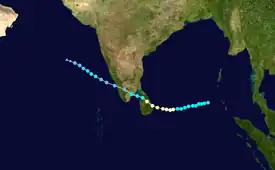1978 Sri Lanka cyclone
The 1978 Sri Lanka Cyclone (JTWC designation: 04B) was one of the most destructive tropical cyclones to strike Sri Lanka since modern records began. The cyclone formed on November 17, 1978, and attained peak intensity on November 23, 1978, right before making landfall in Batticaloa. Sri Lanka's eastern province was heavily affected by the cyclone.[1]
 Cyclone 04B at peak intensity making landfall in Sri Lanka on November 23 | |
| Meteorological history | |
|---|---|
| Formed | November 17, 1978 |
| Dissipated | November 29, 1978 |
| Super cyclonic storm | |
| 3-minute sustained (IMD) | |
| Highest winds | 220 km/h (140 mph) |
| Lowest pressure | 938 hPa (mbar); 27.70 inHg |
| Category 2-equivalent tropical cyclone | |
| 1-minute sustained (SSHWS/JTWC) | |
| Highest winds | 175 km/h (110 mph) |
| Overall effects | |
| Fatalities | ~1000 |
| Damage | $627 million (1978 USD) |
| Areas affected | Eastern Province, Sri Lanka |
| IBTrACS | |
Part of the 1978 North Indian Ocean cyclone season | |
Meteorological history

Tropical storm (39–73 mph, 63–118 km/h)
Category 1 (74–95 mph, 119–153 km/h)
Category 2 (96–110 mph, 154–177 km/h)
Category 3 (111–129 mph, 178–208 km/h)
Category 4 (130–156 mph, 209–251 km/h)
Category 5 (≥157 mph, ≥252 km/h)
Unknown
The storm formed on 17 November over the southwest Bay of Bengal. It intensified gradually, reaching a peak intensity of 220 kmph (140 mph),[2] while the Joint Typhoon Warning Center analyzed the storm as a Category 2 equivalent cyclone on the Saffir–Simpson scale on November 23.[3] The cyclone made landfall in Batticaloa at its peak intensity by the same night. It emerged over the Gulf of Mannar on the 24th. That same evening, the storm made its second landfall in Kilakkarai in Tamil Nadu with one-minute sustained winds of 85 kmph (50 mph).[4] The storm then moved back into the ocean around the Kerala coast. It spent its remaining days over Arabian Sea, eventually dissipating on 29 November.
Impact
The cyclone had devastating impacts in Sri Lanka, killing about 915 people. An estimated more than one million people were affected, with over 250,000 buildings damaged, and one fifth of Batticaloa's fishing fleet destroyed. 9 of the 11 paddy stores were destroyed and 90 percent of the coconut plantation (28,000 odd acres of coconut plantation) in the Batticaloa district had been destroyed. The Sri Lankan government spent over 600 million Sri Lankan rupees in relief efforts in the aftermath of the disaster. A tropical cyclone report noted that over 130 electrical lines were downed and many of religious buildings were reduced to rubble. The cyclone resulted in a substantial number of people being left without electricity and water. Many houses suffered severe structural damage due to its high wind speeds.[5][6]
The impact of the storm in India was minimal. The storm brought some damage to the province of Nadu. In the Ramanathapuram and Tuticorin districts nearly 5000 huts were damaged, and damages in Indian Rupees were estimated to be 5 crores ($626.8 1978 USD). The storm brought rainfall over Kerala and the Lakshadweep Islands.
References
- Neelavannan (1979). 12 மணி நேரம் (The 12 hours). Jaffna, Sri Lanka. p. 29.
{{cite book}}: CS1 maint: location missing publisher (link) - Srinivasan, V., Ramakrishnan, A. R., and Jambunathan, R. Cyclones and depressions in the Indian seas in 1978 (PDF). Meteorological Office, Pune (Report). India Meteorological Department. Retrieved November 26, 2021.
{{cite report}}: CS1 maint: multiple names: authors list (link) - Morford, Dean R. "3.2 North Indian Ocean Tropical Cyclones" (PDF). 1978 Annual Tropical Cyclone Report. Joint Typhoon Warning Center (Report). United States Navy, United States Airforce. Retrieved November 25, 2021.
- "1978 Very Severe Cyclonic Storm NOT_NAMED (1978323N08092)". International Best Track Archive for Climate Stewardship. National Centers for Environmental Information; University of North Carolina Asheville. Retrieved November 25, 2021.
- "Disaster Information Management system in Sri Lanka". www.desinventar.lk.
- "Batticaloa's blackest day". Archived from the original on 2015-09-24. Retrieved 2013-12-05.
External links